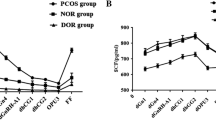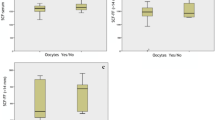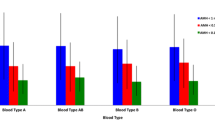Abstract
In humans, stem cell factor (SCF), produced during follicular phase, may reflect a successful stimulation and oocyte maturation and so it may be a predictor of in vitro fertilization (IVF) outcome. An observational cohort study was conducted on 37 poor responders scheduled for fresh nondonor IVF/intracytoplasmic sperm injection treatment with standard controlled ovarian stimulation (COS) using recombinant follicle-stimulating hormone (rFSH; S-COS group). A total of 35 women received a second treatment using both rFSH and recombinant luteinizing hormone (rLH; LH-COS group). From 144 samples collected at pickup day, serum concentration of SCF (s-SCF) and follicular levels of SCF (f-SCF) were measured by enzyme-linked immunosorbent assay (ELISA) kit. No differences were observed between the 2 protocols in terms of both f-SCF and s-SCF levels. The comparison between f-SCF and s-SCF levels showed a strong linear correlation. The comparison between s-SCF levels and clinical outcomes showed a statistically significant correlation between both the number of metaphase II (MII) oocytes retrieved and the embryos obtained after fertilization. Cases with at least 3 MII oocytes showed s-SCF values >800 pg/mL, 2 MII oocytes >600 pg/mL, and 1 MII oocytes >400 pg/mL. In 100% of cases with s-SCF <400 pg/mL, no MII oocytes were recovered. All 5 pregnancies occurred in patients with s-SCF values >1000 pg/mL. The introduction of s-SCF assay in the management of poor-responder patients may contribute to solving the dilemma of whether to cancel or proceed with the stimulation cycle.
Similar content being viewed by others
References
Qiao J, Wang ZB, Feng HL, et al. The root of reduced fertility in aged women and possible therapentic options: current status and future perspects. Mol Aspects Med. 2014;38:54–85.
Gizzo S, Andrisani A, Esposito F, et al. Ovarian reserve test: an impartial means to resolve the mismatch between chronological and biological age in the assessment of female reproductive chances. Reprod Sci. 2014;21(5):632–639.
Repubblica Italiana—Bollettino Ufficiale—Regione Del Veneto. Disposizioni in materia di attività di Procreazione Medicalmente Assistita (Pma). Venezia, venerdì 8 luglio 2011 Anno XLII -N. 49. Web site. http://bur.regione.veneto.it/BurvServices/pubblica/DettaglioDgr.aspx?id=233370. Published July 8, 2011. Accessed August 1, 2011.
Gizzo S, Andrisani A, Noventa M, et al. Recombinant LH supplementation during IVF cycles with GnRH-antagonist protocols in estimated poor responders: what is the best daily-dose and timing to administer it? A cross-matched pilot study[published online June 9, 2015]. Mol Med Rep. 2015.
Ulug U, Ben-Shlomo I, Turan E, Erden HF, Akman MA, Bahceci M. Conception rates following assisted reproduction in poor responder patients: a retrospective study in 300 consecutive cycles. Reprod Biomed Online. 2003;6(4):439–443.
Besmer P. The kit ligand encoded at the murine Steel locus: a pleiotropic growth and differentiation factor. Curr Opin Cell Biol. 1991;3(6):939–946.
Manova K, Huang EJ, Angeles M, et al. The expression pattern of the c-kit ligand in gonads of mice supports a role for the c-kit receptor in oocyte growth and in proliferation of spermatogonia. Dev Biol. 1993;157(1):85–99.
Motro B, Bernstein A. Dynamic changes in ovarian c-kit and Steel expression during the estrous reproductive cycle. Dev Dyn. 1993;197(1):69–79.
Laitinen M, Rutanen EM, Ritvos O. Expression of c-kit ligand messenger ribonucleic acids in human ovaries and regulation of their steady state levels by gonadotropins in cultured granulosaluteal cells. Endocrinology. 1995;136(10):4407–4414.
Tanikawa M, Harada T, Mitsunari M, Onohara Y, Iwabe T, Terakawa N. Expression of c-kit messenger ribonucleic acid in human oocyte and presence of soluble c-kit in follicular fluid. J Clin Endocrinol Metab. 1998;83(4):1239–1242.
Tanikawa M, Harada T, Ito M, Enatsu A, Iwabe T, Terakawa N. Presence of stem cell factor in follicular fluid and its expression in the human ovary. Fertil Steril. 2000;73(6):1259–1260.
Salmassi A, Zorn S, Mettler L, Koch K, Jonat W, Schmutzler AG. Circulating concentration of stem cell factor in serum of stimulated IVF patients. Reprod Biomed Online. 2011;22(2):140–147.
Celik O, Celik E, Yilmaz E, et al. Effect of ovarian stimulation with recombinant follicle-stimulating hormone, gonadotropin-releasing hormone agonist and antagonists, on follicular fluid stem cell factor and serum urocortin 1 levels on the day of oocyte retrieval. Arch Gynecol Obstet. 2013;288(6):1417–1422.
Patrelli TS, Gizzo S, Sianesi N, et al. Anti-Müllerian hormone serum values and ovarian reserve: can it predict a decrease in fertility after ovarian stimulation by ART cycles? PLoS One. 2012;7(9):e44571.
Hu R, Lou Y, Wang FM, et al. Effects of recombinant human AMH on SCF expression in human granulosa cells. Cell Biochem Biophys. 2013;67(3):1481–1485.
Hu R, Wang FM, Yu L, et al. Antimüllerian hormone regulates stem cell factor expression in human granulosa cells. Fertil Steril. 2014;102(6):1742–1750.e1.
Aboulghar M, Saber W, Amin Y, Aboulghar MM, Serour G, Mansour R. Impact of antimüllerian hormone assays on the outcomes of in vitro fertilization: a prospective controlled study. Fertil Steril. 2014;101(1):134–137.
Ferraretti AP1, La Marca A, Fauser BC, et al. ESHRE consensus on the definition of ‘poor response’ to ovarian stimulation for in vitro fertilization: the Bologna criteria. Hum Reprod. 2011;26(7):1616–1624.
Patrelli TS, Berretta R, Gizzo S, et al. CA 125 serum values in surgically treated endometriosis patients and its relationships with anatomic sites of endometriosis and pregnancy rate. Fertil Steril. 2011;95(1):393–396.
Saccardi C, Conte L, Fabris A, et al. HysteroscopicEnucleation in toto of submucous type 2 myomas: long-term follow-up in women affected by menorrhagia. Minim Invasive Gynecol. 2014;21(3):426–430.
Litta P, Cosmi E, Saccardi C, Esposito C, Rui R, Ambrosini G. Outpatient operative polypectomy using a 5 mm-hysteroscope without anaesthesia and/or analgesia: advantages and limits. Eur J Obstet Gynecol Reprod Biol. 2008;139(2):210–214
Gizzo S, Capuzzo D, Zicchina C, et al. Could empirical low-doseaspirin administration during IVF cycle affect both the oocytes and embryos quality via COX 1–2 activity inhibition? J Assist Reprod Genet. 2014;31(3):261–268.
Neuber E, Rinaudo P, Trimarchi JR, Sakkas D. Sequential assessment of individually cultured human embryos as an indicator of subsequent good quality blastocyst development. Hum Reprod. 2003;18(6):1307–1312.
Gizzo S, Andrisani A, Esposito F, et al. Which luteal phase support is better for each IVF stimulation protocol to achieve the highest pregnancy rate? A superiority randomized clinical trial[published online September 30, 2014]. Gynecol Endocrinol. 2014:1–7.
Busnelli A, Papaleo E, Del Prato D, et al. A retrospective evaluation of prognosis and cost-effectiveness of IVF in poor responders according to the Bologna criteria. Hum Reprod. 2015;30(2):315–322.
Oudendijk JF, Yarde F, Eijkemans MJ, Broekmans FJ, Broer SL. The poor responder in IVF: is the prognosis always poor?: a systematic review. Hum Reprod Update. 2012;18(1):1–11.
Gizzo S, Andrisani A, Noventa M, et al. Menstrual cycle length: a surrogate measure of reproductive health capable of improving the accuracy of biochemical/sonographical ovarian reserve test in estimating the reproductive chances of women referred to ART. Reprod Biol Endocrinol. 2015;13(1):28.
La Marca A, Sunkara SK. Individualization of controlled ovarian stimulation in IVF using ovarian reserve markers: from theory to practice. Hum Reprod Update. 2014;20(1):124–140.
Author information
Authors and Affiliations
Corresponding author
Rights and permissions
About this article
Cite this article
Gizzo, S., Quaranta, M., Andrisani, A. et al. Serum Stem Cell Factor Assay in Elderly Poor Responder Patients Undergoing IVF: A New Biomarker to Customize Follicle Aspiration Cycle by Cycle. Reprod. Sci. 23, 61–68 (2016). https://doi.org/10.1177/1933719115594020
Published:
Issue Date:
DOI: https://doi.org/10.1177/1933719115594020




